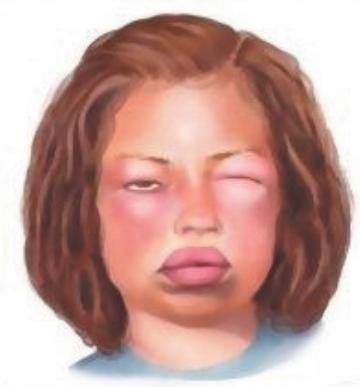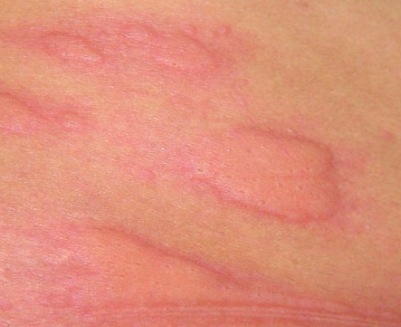UTICARIA HIVES

Got an itch to scratch?
Ever have that sense of itching or need to scratch that just cannot be satisfied? Or found yourself covered with lesions that are fairly intense itches, where the scratch simply results in a greater itch and spreading of the lesions?
 Described above is the most common manifestation of urticaria, or hives, as it is most commonly referred to. Causes can be due to an immunologic (involving the body’s
immune system) or nonimmunologic cause. Physiologically, urticaria is a
vascular reaction of the skin manifested by the appearance of slightly
elevated patches (weals) that are usually paler, although can also be a
darker red than the surrounding skin and often associated with severe
itching. They appear in varying shapes and sizes, and lesions in true
urticaria last no more than 24 hours. For less fortunate patients, this
condition can be more chronic, lasting days to months or even years. It
is estimated that 20 percent of all people will experience hives at some
time in their lives. They present more commonly in women than men. A
hallmark of the condition is that the lesion changes size rapidly, and
as quickly as one resolves, another one develops in another location.
Because of this tendency to fluctuate and even resolve between
outbreaks, it is helpful to take pictures of the affected areas when the
eruptions are at their worst to reference when you seek medical
evaluation.
Described above is the most common manifestation of urticaria, or hives, as it is most commonly referred to. Causes can be due to an immunologic (involving the body’s
immune system) or nonimmunologic cause. Physiologically, urticaria is a
vascular reaction of the skin manifested by the appearance of slightly
elevated patches (weals) that are usually paler, although can also be a
darker red than the surrounding skin and often associated with severe
itching. They appear in varying shapes and sizes, and lesions in true
urticaria last no more than 24 hours. For less fortunate patients, this
condition can be more chronic, lasting days to months or even years. It
is estimated that 20 percent of all people will experience hives at some
time in their lives. They present more commonly in women than men. A
hallmark of the condition is that the lesion changes size rapidly, and
as quickly as one resolves, another one develops in another location.
Because of this tendency to fluctuate and even resolve between
outbreaks, it is helpful to take pictures of the affected areas when the
eruptions are at their worst to reference when you seek medical
evaluation.
The various causes of urticaria can include an allergic reaction to food or medications, infections in the body, or emotional stress; most commonly, however, the cause is idiopathic (meaning that is due to an obscure or of unknown cause). Some patients can develop hives in response to physical stimulation by the environment like heat or cold. In patients with heat urticaria, their symptoms are brought on by a rise in core body temperature that may result from infections, showers or exercising. Cold urticaria in contrast is triggered by exposure to cold or wind, and this is usually an acquired or inherited condition. Control of these types of urticaria is primarily through controlling the triggers.
Other less common types of urticaria include delayed pressure urticaria, where pressure applied to a part of the body causes swelling and discomfort and may or may not manifest with itching. Also, aquagenic urticaria, where hives develop because of water exposure; vibratory urticaria, resulting from exposure to vibration; and solar urticaria, where sun exposure either from visible light and/or UV light causes symptoms.
Some patients manifest with a more significant and worse appearing form of this condition called angioedema, which indicates there is involvement of the deeper skin tissue and involves swelling of the lips, eyelids, tongue, palms, soles and/or genitalia. It should be noted that angioedema is no more likely than urticaria to be associated with systemic complications manifested as anaphylaxis (i.e., swelling of the throat or collapse of the vascular system).
Regardless of the cause of this condition, the mainstay of treatment is directed at symptomatic relief until the condition spontaneously resolves or control is obtained by treatment of the underlying trigger (i.e., infection, food allergy, medication allergy, etc.). Most commonly, the treatment for urticaria includes use of antihistamine medications. In the body, there are four main types of histamine, which include H1, H2, H3 and H4. In the treatment of urticaria, a single H1-blocking agent or in combination with H2 blockers is most commonly used and effective.
H1-blocking
medications include Hydroxyzine (Atarax ® ), Diphenhydramine (Benadryl ®
), Cyproheptadine (Periactin ® ), Cetirizine (Zyrtec ® ),
Levocetirizine (Xyza ® ), Fexofenadine (Allegra ® ), Loratadine
(Claritin ® ) or Desloratidine (Clarinex ® ). H2 blocker medications
include Famotidine (Pepcid ® ), Cimetidine (Tagamet ® ), Ranitidine
(Zantac ® )
or Nizatidine (Axid ® ). Systemic corticosteroids can be used to
suppress acute or chronic urticaria; however, they have other
undesirable side effects and are rarely indicated, as properly selected
combinations of antihistamine medications are usually effective and are
overall less toxic to the body. For patients with chronic urticaria,
withdrawal from the steroids usually will result in return of the
symptoms. Other options include immunosuppressive medications or a
monthly injection (Xolair ® ), which has an indication for urticaria
that fails to respond to high-dose antihistamines.
For patients with chronic urticaria, defined as urticaria that lasts longer than six weeks, it is important to seek other potential underlying causes as the trigger for the urticaria despite the poor association with causative medical conditions and urticaria. In a published review of more than 6,000 patients with chronic urticaria, a causative condition was only found in 1.6 percent of them illustrating the primarily idiopathic etiology. When studies are obtained, they may include liver function testing, thyroid function and thyroid antibodies testing, evaluation for rheumatologic conditions, gastrointestinal conditions or food allergy testing.
As allergy providers at Highland Clinic, we can obtain these various laboratory testing and perform skin testing for food allergies, if indicated. In order to perform food allergy testing, a patient should be off of all antihistamine medications (see list of H1 and H2 medications earlier in this article) for preferably five days prior to skin testing.
Robert Baye, MPAS, PA-C, FAAPA is full-time in the allergy/asthma clinic working alongside Drs. Whited and Johnson. He evaluates new and established patients to the practice for their conditions related to allergies, asthma and immunology. He can be reached at (318) 798-4651, 1455 East Bert Kouns Industrial Loop, Suite 106, Shreveport, LA. His office website is http://www.highlandclinic.com/staff/robert-baye-pac-mpas-faapa or visit Facebook https://www.facebook.com/highlandasthmaandallergy/.
